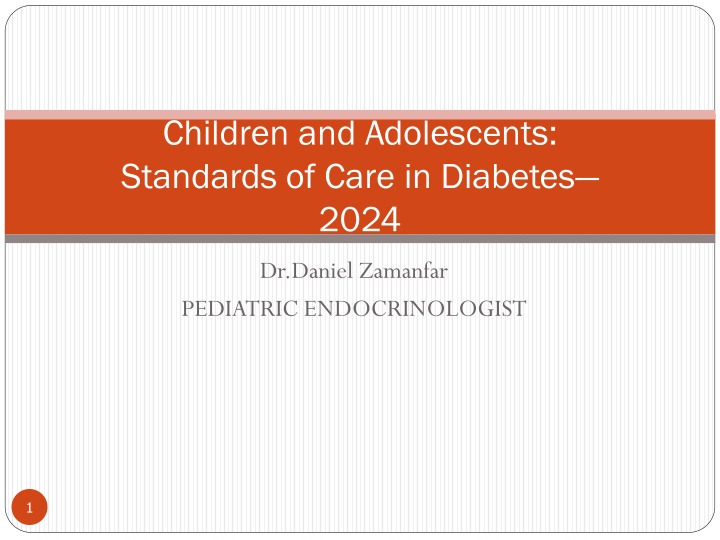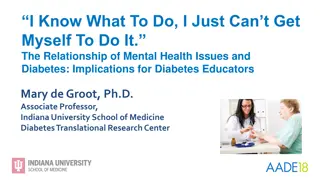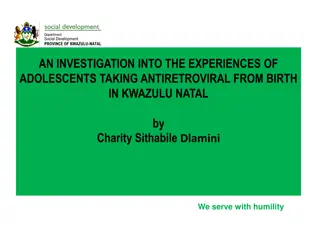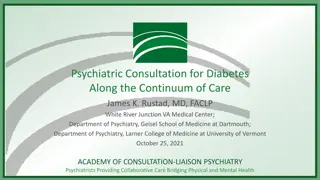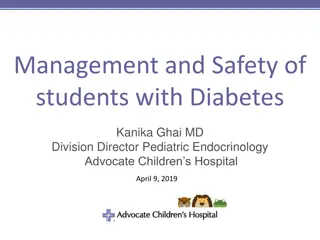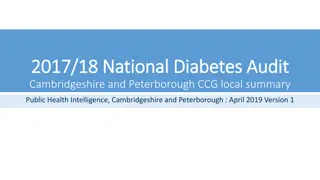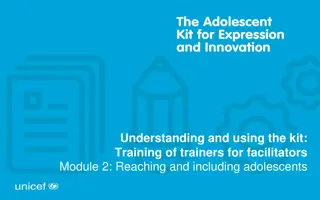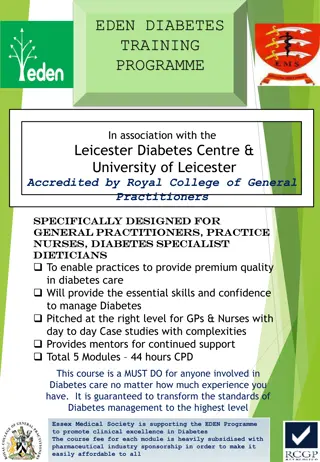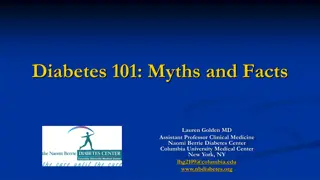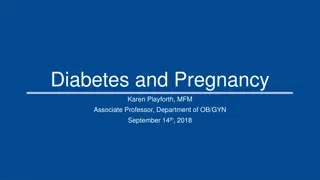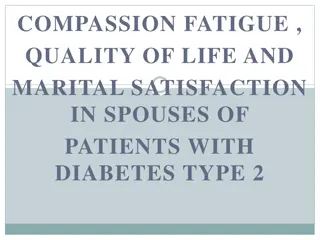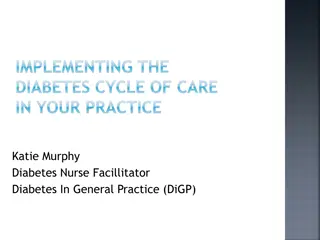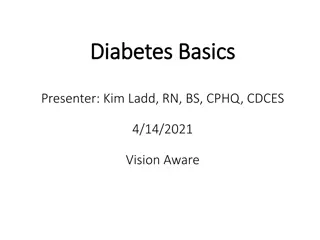Children and Adolescents: Standards of Care in Diabetes
The American Diabetes Association (ADA) Standards of Care in Diabetes provide clinical recommendations for children and adolescents with diabetes, emphasizing the need for age-appropriate care, developmental considerations, and individualized treatment plans. Managing type 1 diabetes in youth involves unique challenges related to growth, self-care abilities, supervision needs, and neurological vulnerabilities. It is essential for healthcare professionals to understand the specialized care required for pediatric diabetes.
Download Presentation

Please find below an Image/Link to download the presentation.
The content on the website is provided AS IS for your information and personal use only. It may not be sold, licensed, or shared on other websites without obtaining consent from the author.If you encounter any issues during the download, it is possible that the publisher has removed the file from their server.
You are allowed to download the files provided on this website for personal or commercial use, subject to the condition that they are used lawfully. All files are the property of their respective owners.
The content on the website is provided AS IS for your information and personal use only. It may not be sold, licensed, or shared on other websites without obtaining consent from the author.
E N D
Presentation Transcript
Children and Adolescents: Standards of Care in Diabetes 2024 Dr.Daniel Zamanfar PEDIATRIC ENDOCRINOLOGIST 1
The American Diabetes Association (ADA) Standards of Care in Diabetes includes the ADA s current clinical practice recommendations and is intended to provide the components of diabetes care, general treatment goals and guidelines, and tools to evaluate quality of care. 2
The management of diabetes in children and adolescents (individuals <18 years of age) cannot simply be derived from care routinely provided to adults with diabetes. The epidemiology, pathophysiology, developmental considerations, and response to therapy in pediatric diabetes are often different from those of adult diabetes. There are also differences in recommended care for children and adolescents with type 1 diabetes, type 2 diabetes, and other forms of pediatric diabetes. 3
In addition to comprehensive diabetes care, youth with diabetes should receive age-appropriate and developmentally appropriate pediatric care, including immunizations as recommended by the Centers for Disease Control and Prevention (CDC). 4
Type 1 diabetes is the most common form of diabetes in youth , although data suggest that it accounts for a large proportion of cases diagnosed in adult life. 7
The health care professional must consider the unique aspects of care and management of children and adolescents with type 1 diabetes, such as changes in insulin sensitivity related to physical growth and sexual maturation, ability to provide self-care, supervision in the childcare and school environment, neurological vulnerability to hypoglycemia and hyperglycemia in young children, and possible adverse neurocognitive effects of diabetic ketoacidosis (DKA). 8
An interprofessional team trained in pediatric diabetes management and sensitive to the challenges of children and adolescents with type 1 diabetes and their families should provide diabetes-specific care for this population. It is essential that diabetes self-management education and support, medical nutrition therapy, and psychosocial/behavioral support be provided at diagnosis and regularly thereafter in a developmentally appropriate format. 9
As a large portion of a youths day is spent in school and/or day care, training of school or day care personnel to provide care in accordance with the child s individualized diabetes medical management plan is essential for optimal diabetes management and safe access to all school or day care sponsored opportunities. 11
Rapid and dynamic cognitive, developmental, and emotional changes occur during childhood, adolescence, and emerging adulthood. Diabetes management during childhood and adolescence places substantial burdens on the youth and family, necessitating ongoing assessment of psychosocial status, social determinants of health, and diabetes distress in the youth and the parents/caregivers during routine diabetes visits. 13
It is important to consider the impact of diabetes on quality of life as well as the development of behavioral health problems related to diabetes distress, fear of hypoglycemia (and hyperglycemia), symptoms of anxiety, disordered eating behaviors and eating disorders, and symptoms of depression. 14
Consider screening youth for diabetes distress, generally starting at 7 or 8 years of age (56), using validated tools for youth and their parents/caregivers. Consider screening for depression and disordered eating behaviors using available screening tools. Early detection of depression, anxiety, disordered eating, and learning disabilities can facilitate effective treatment options and help minimize adverse effects on diabetes management and disease outcomes. 15
Recommendations At diagnosis and during routine follow-up care, screen youth with type 1 diabetes for psychosocial concerns (e.g., diabetes distress, depressive symptoms, and disordered eating),family factors, and behavioral health concerns that could impact diabetes managementwith age-appropriate standardized and validated tools. Refer to a qualified behavioral health professional, preferably experienced in childhood diabetes, when indicated. B 16
Encourage developmentally appropriate family involvement in diabetes management tasks for children and adolescents, recognizing that premature or unsupportive transfer of diabetes care responsibility to the youth can contribute to diabetes distress, lower engagement in diabetes selfmanagement behaviors, and deterioration in glycemia. A 17
Health care professionals should consider asking youth and their parents/ caregivers about social adjustment (peer relationships) and school performance to determine whether further intervention is needed. B 18
Starting at puberty, preconception counseling should be incorporated into routine diabetes care for all individuals of childbearing potential. A 19
Glycemic Monitoring, Insulin Delivery, and Goals 20
Current standards for diabetes management reflect the need to minimize hyperglycemia as safely as possible. In addition, type 1 diabetes can be associated with adverse effects on cognition during childhood and adolescence, and neurocognitive imaging differences related to hyperglycemia in children provide another motivation for achieving glycemic goals. 21
DKA has been shown to cause adverse effects on brain development and function. Additional factors that contribute to adverse effects on brain development and function include young age, severe hypoglycemia at <6 years of age, and chronic hyperglycemia. 22
Recommendations All youth with type 1 diabetes should monitor glucose levels multiple times daily (up to 6 10 times/day by blood glucose meter or CGM), including prior to meals and snacks, at bedtime, and as needed for safety in specific situations such as physical activity, driving, or the presence of symptoms of hypoglycemia. B 23
Students must be supported at school in the use of diabetes technology, including continuous glucosemonitors, insulin pumps, connected insulin pens, and AID systems as prescribed by their diabetes care team. E 24
A1C goalsmust be individualized and reassessed over time. An A1C of <7% (<53 mmol/mol) is appropriate formany children and adolescents. B 25
Less stringent A1C goals (such as <7.5% [<58 mmol/mol]) may be appropriate for youth > who cannot articulate symptoms of hypoglycemia; > have hypoglycemia unawareness; > lack access to analog insulins advanced insulin delivery technology, and/or CGM; > cannot check blood glucose regularly; > or have nonglycemic factors that increase A1C (e.g., high glycators). B 26
Even less stringent A1C goals (such as <8% [<64 mmol/mol]) may be appropriate for individuals with: > a history of severe hypoglycemia, > limited life expectancy > or where the harms of treatment are greater than the benefits. B 27
Health care professionals may reasonably suggest more stringent A1C goals (such as<6.5% [<48 mmol/mol]) for selected individuals if they can be achieved without significant hypoglycemia, negative impacts on well-being, or undue burden of care or in those who have nonglycemic factors that decrease A1C (e.g., lower erythrocyte life span). Lower goals may also be appropriate during the honeymoon phase. B 28
CGM metrics derived from continuous glucose monitor use over the most recent 14 days (or longer for youth with more glycemic variability), including : > time in range (70 180 mg/dL), > time below range(<70 mg/dL and <54 mg/dL ) > time above range (>180 mg/dL and >250 mg/dL), are recommended to be used in conjunction with A1C whenever possible. E 29
Key Concepts in Setting Glycemic Goals Glycemic goals should be individualized, and lower goals may be reasonable based on a benefit risk assessment. Blood glucose goals should be modified in children with frequent hypoglycemia or hypoglycemia unawareness. Postprandial blood glucose values should be measured when there is a discrepancy between preprandial blood glucose values and A1C levels and to assess preprandial insulin doses in those on basal-bolus or pump plans. 30
Because of the increased frequency of other autoimmune diseases in type 1 diabetes, screening for thyroid dysfunction and celiac disease should be considered. Periodic screening in asymptomatic individuals has been recommended,but the optimal frequency of screening is unclear. 32
Although much less common than thyroid dysfunction and celiac disease, other autoimmune conditions, such as Addison disease (primary adrenal insufficiency), autoimmune hepatitis, autoimmune gastritis, dermatomyositis, and myasthenia gravis, occurmore commonly in the population with type 1 diabetes than in the general pediatric population and should be assessed and monitored as clinically indicated. In addition, relatives of youth with type 1 diabetes should be offered testing for islet autoantibodies. 33
Recommendation Assess for additional autoimmune conditions soon after the diagnosis of type 1 diabetes and if symptoms develop. B 34
Autoimmune thyroid disease is the most common autoimmune disorder associated with diabetes, occurring in 17 30% of individuals with type 1 diabetes. At the time of diagnosis, 25% of children with type 1 diabetes have thyroid autoantibodies , the presence of which is predictive of thyroid dysfunction most commonly hypothyroidism, although hyperthyroidism occurs in 0.5% of people with type 1 diabetes. 36
Thyroid function tests may be misleading (euthyroid sick syndrome) if performed at the time of diagnosis owing to the effect of previous hyperglycemia, ketosis or ketoacidosis, weight loss, etc. Therefore, if performed at diagnosis and slightly abnormal, thyroid function tests should be repeated soon after a period of metabolic stability and achievement of glycemic goals. 37
Recommendations Consider testing children with type 1 diabetes for antithyroid peroxidase and antithyroglobulin antibodies soon after diagnosis. B 38
Measure thyroid-stimulating hormone concentrations at diagnosis when clinically stable or soon after optimizing glycemia. If normal, suggest rechecking every 1 2 years or sooner if the youth has positive thyroid antibodies or develops symptoms or signs suggestive of thyroid dysfunction, thyromegaly, an abnormal growth rate, or unexplained glycemic variability. B 39
Celiac disease is an immune-mediated disorder that occurs with increased frequency in people with type 1 diabetes (1.6 16.4% of individuals compared with 0.3 1% in the general population). Screening people with type 1 diabetes for celiac disease is further justified by its association with osteoporosis,iron deficiency, growth failure, and potential increased risk of retinopathy and albuminuria. 41
Recommendations Screen youth with type 1 diabetes for celiac disease by measuring IgA tissue transglutaminase (tTG) antibodies,with documentation of normal total serum IgA levels, soon after the diagnosis of diabetes, or IgG tTG and deamidated gliadin antibodies if IgA is deficient. B 42
Repeat screening for celiac disease within 2 years of diabetes diagnosis and then again after 5 years and consider more frequent screening in youth who have symptoms or a first degree relative with celiac disease. B 43
Individuals with confirmed celiac disease should be placed on a gluten-free diet for treatment and to avoid complications. Youth and their caregivers should also have a consultation with a registered dietitian nutritionist experienced in managing both diabetes and celiac disease. B 44
Management of Cardiovascular Risk Factors 45
Recommendation Blood pressure should be measured at every routine visit. In youth with high blood pressure (blood pressure 90th percentile for age, sex, and height or, in adolescents aged 13 years, blood pressure 120/80 mmHg) on three separate measurements, ambulatory blood pressure monitoring should be strongly considered.B 47
Recommendations Treatment of elevated blood pressure (defined as 90th to <95thpercentile for age, sex, and height or, in adolescents aged 13 years,120 129/<80 mmHg) is lifestyle modification focused on healthy nutrition,physical activity, sleep, and, if appropriate, weight management. C 49
In addition to lifestyle modification, ACE inhibitors or angiotensin receptor blockers should be started for treatment of confirmed hypertension (defined as blood pressure consistently 95th percentile for age, sex, and height or, in adolescents aged 13 years, 130/80 mmHg).B 50
